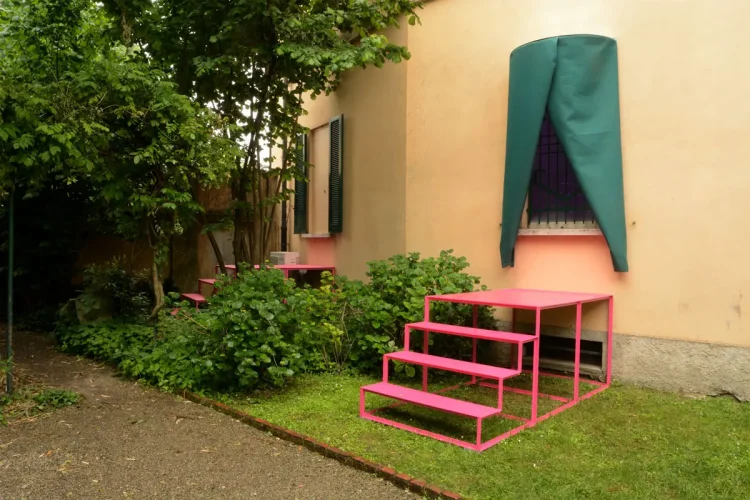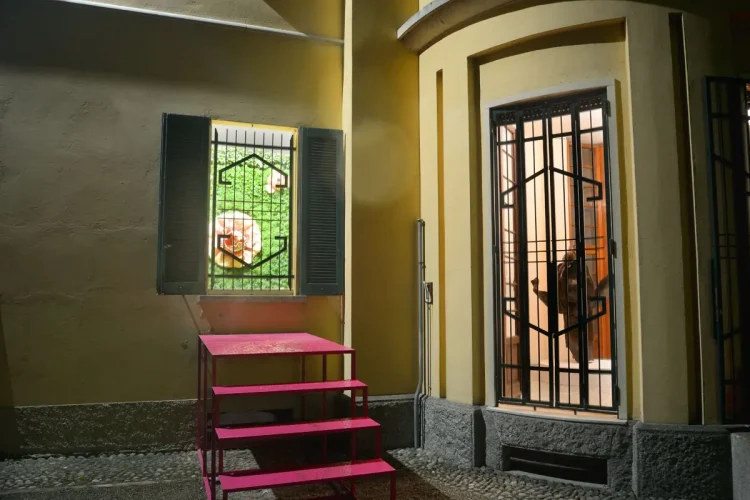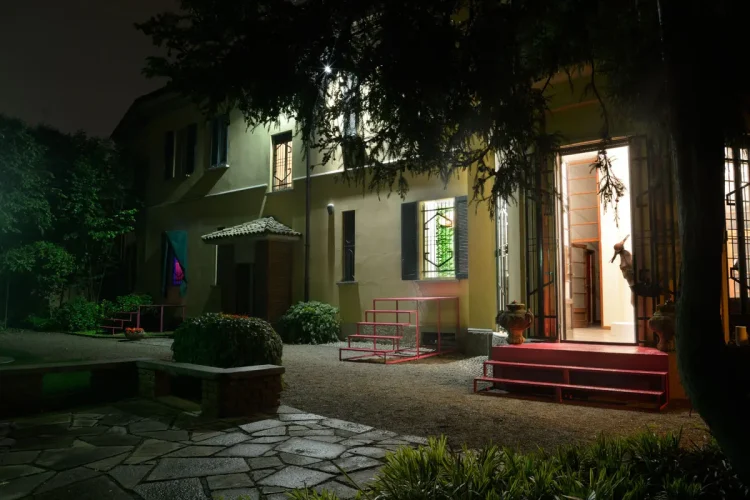MUOVERSI PER VEDERE
Daniele Capra
[…]
Benché la coreutica sia da me culturalmente molto distante dalla mia rigidezza fisica, mi capita sempre di praticare una piccola danza sincopata quando entro nello studio di Matteo Negri. Non so se lui lo faccia apposta per farmi muovere (ipotesi plausibilissima, benedetta dagli ortopedici), ma è molto più probabile che sia in lui innato l’impulso a creare opere che stimolano l’osservatore ad adottare un approccio cinetico, che incoraggia a guardare e confrontare da più punti di vista. Questo è uno degli aspetti più personali ed interessanti della sua ricerca: lottare contro la staticità e la pigrizia dello spettatore.
Il progetto elaborato per Casa Testori, di grande impatto visivo, è mirato proprio a ribaltare le modalità di ricezione del luogo, il percorso implicito con cui lo spazio espositivo è fruito. Il visitatore, infatti, è costretto ad adottare un punto vista esterno all’edificio. Le opere ospitate nelle stanze della casa son infatti visibili esclusivamente dall’esterno, spingendo il visitatore ad essere nel contempo osservatore e uomo in movimento, cioè spettatore e ballerino.
Il progetto Splendida villa con giardino, viste incantevoli, il cui titolo, che ha delle reminiscenze della gaddiana Cognizione del dolore, allude al lessico impiegato negli annunci di compravendita immobiliare, nasce dall’analisi delle funzionalità delle single stanze di Casa Testori, connotate ciascuna da finalità abitativo di ordine differente. Negri sceglie invece di cambiare visivamente la loro destinazione d’uso, trasformando ciascun spazio in un luogo fisicamente inaccessibile alle persone, ma visibile dalle finestre del giardino. Non solo, quindi, i percorsi cambiano, ma il visitatore cessa di essere banalmente attore passivo di un percorso già stabilito per diventare invece persona esortata ad andare alla scoperta dei contenuti proposti. Il visitatore diventa così flâneur che interagisce con gli stimoli ambientali che gli si pongono innanzi: non più ricettore di contenuti, ma esso stesso scopritore.
Le opere di Splendida villa con giardino, viste incantevoli testimoniano la poliedrica abilità di Matteo Negri, e spaziano da installazioni di carattere ambientale, realizzate con specchi speciali, luci teatrali e piante, a sculture in cui vengono impiegati materiali compositi (come resine epossidiche, silicone), fino alle scritte luminose nel giardino. E poi il più classico bronzo, utilizzato per la grande scultura rotate che occupa lo spazio maggiore della dimora Testori – una Vespa Piaggio smembrata e ricostituita – che non viene imprigionata nel metallo, ma trasformata in un dispositivo che consente esso stesso di dare più punti di osservazione.
Continuo ad avere dubbi se la scultura abbia delle finalità differenti rispetto la pratica artistica bidimensionale. Ma, con certezza, possiamo dire che Negri faccia di tutto per dire che vedere voglia dire muoversi, danzare, avere un ritmo cinetico. Col mio piede, sto già battendo il tempo.
[…]





LA MOSTRA
Cinque interventi scultorei site-specific per gli spazi del piano terra e per il giardino della dimora di Novate Milanese. Splendida villa con giardino, viste incantevoli, mostra personale di Matteo Negri, è il progetto, di grande impatto visivo, che ha ribaltato il punto di vista e le modalità di fruizione del luogo: le opere ospitate nelle stanze della casa erano, infatti, visibili solo dall’esterno, spingendo il visitatore a essere nel contempo osservatore e protagonista.
La mostra, curata da Daniele Capra, è corredata da una pubblicazione bilingue con le immagini delle opere negli spazi della casa, i testi del curatore, un contributo critico di Flaminio Gualdoni e un’intervista all’artista di Giuseppe Frangi.
L’evento, assieme alla personale di Andrea Bianconi, era parte della mostra di Casa Testori A doppio senso, ed è stata realizzata in collaborazione con ABC-ARTE, Genova.
La ricerca di Matteo Negri (San Donato, 1982) è caratterizzata da un interesse prevalente per la scultura, benché non manchino lavori di carattere bidimensionale. Ospitate frequentemente in contesti pubblici, come ad esempio in Piazza Gae Aulenti a Milano (Multiplicity, 2015) e in diverse piazze a Parigi (L’egosÏme 2010), le sue opere attivano gli spazi con un senso di ludica meraviglia.
